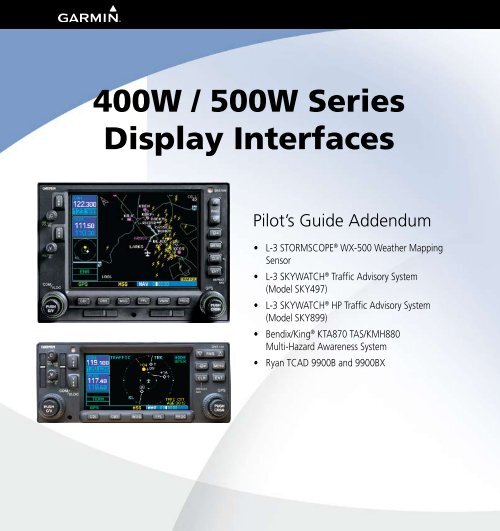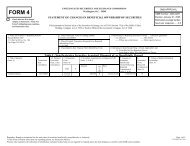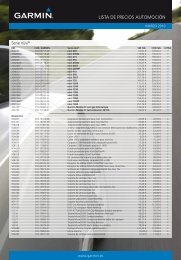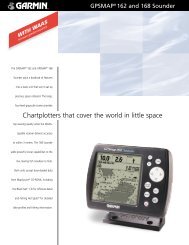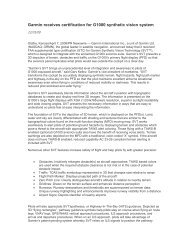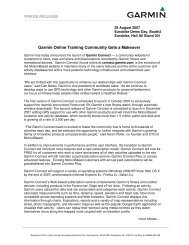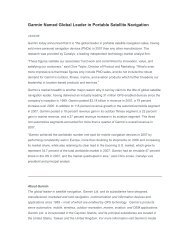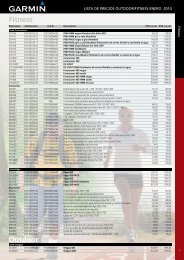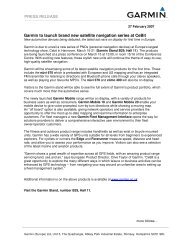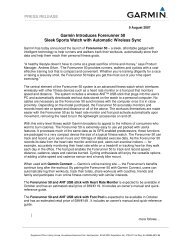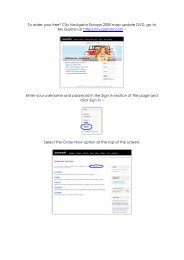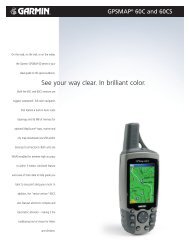400W / 500W Series Display Interfaces - Garmin
400W / 500W Series Display Interfaces - Garmin
400W / 500W Series Display Interfaces - Garmin
You also want an ePaper? Increase the reach of your titles
YUMPU automatically turns print PDFs into web optimized ePapers that Google loves.
<strong>400W</strong> / <strong>500W</strong> <strong>Series</strong><br />
<strong>Display</strong> <strong>Interfaces</strong><br />
Pilot’s Guide Addendum<br />
• L-3 STORMSCOPE ® WX-500 Weather Mapping<br />
Sensor<br />
• L-3 SKYWATCH ® Traffic Advisory System<br />
(Model SKY497)<br />
• L-3 SKYWATCH ® HP Traffic Advisory System<br />
(Model SKY899)<br />
• Bendix/King ® KTA870 TAS/KMH880<br />
Multi-Hazard Awareness System<br />
• Ryan TCAD 9900B and 9900BX
This Pilot’s Guide Addendum is written for:<br />
• <strong>Garmin</strong> GPS <strong>400W</strong>, GNC 420W/420AW, and GNS 430W/430AW Main System Software Versions 2.00, 3.00, and<br />
later<br />
• <strong>Garmin</strong> GPS <strong>500W</strong> & GNS 530W/530AW Main System Software Versions 2.00, 3.00, and later<br />
Some differences in operation may be observed when comparing the information in this manual to earlier or later software<br />
versions.<br />
© 2009 <strong>Garmin</strong> Ltd. or its subsidiaries. All Rights Reserved.<br />
<strong>Garmin</strong> International, Inc., 1200 East 151st Street, Olathe, KS 66062, U.S.A.<br />
Tel. 913/397.8200 or 800/800.1020 Fax 913/397.8282<br />
<strong>Garmin</strong> AT, Inc., 2345 Turner Rd., S.E., Salem, Oregon 97302, U.S.A.<br />
Tel: 503/581.8101 Fax: 503/364.2138<br />
<strong>Garmin</strong> (Europe) Ltd., Liberty House, Bulls Copse Road, Hounsdown Business Park, Southhampton, SO40 9RB, U.K.<br />
Tel. +44 (0) 870 850 1243 Fax +44 (0) 238 052 4004<br />
<strong>Garmin</strong> Corporation, No. 68, Jangshu 2nd Road, Shijr, Taipei County, Taiwan<br />
Tel. 886/2.2642.9199 Fax 886/2.2642.9099<br />
Except as expressly provided herein, no part of this addendum may be reproduced, copied, transmitted, disseminated,<br />
downloaded or stored in any storage medium, for any purpose without the express prior written consent of <strong>Garmin</strong>. <strong>Garmin</strong><br />
hereby grants permission to download a single copy of this manual and of any revision to this manual onto a hard drive<br />
or other electronic storage medium to be viewed and to print one copy of this manual or of any revision hereto, provided<br />
that such electronic or printed copy of this manual or revision must contain the complete text of this copyright notice and<br />
provided further that any unauthorized commercial distribution of this manual or any revision hereto is strictly prohibited.<br />
Information in this document is subject to change without notice. <strong>Garmin</strong> reserves the right to change or improve its<br />
products and to make changes in the content without obligation to notify any person or organization of such changes or<br />
improvements.<br />
January 2009 Part Number 190-00356-31 Rev. D Printed in U.S.A.<br />
<strong>Garmin</strong> ® is a registered trademark of <strong>Garmin</strong> Ltd. or its subsidiaries and may not<br />
be used without the express permission of <strong>Garmin</strong> Ltd. or its subsidiaries. STORM-<br />
SCOPE ® and SKYWATCH ® are registered trademarks of L-3 Avionics Systems, Inc.<br />
Bendix/King ® is a registered trademark of Honeywell International, Inc.
190-00356-31 Rev. D<br />
Foreward<br />
Warnings and Cautions<br />
CAUTION: The Global Positioning System is operated by the United States government, which is solely responsible for its<br />
accuracy and maintenance. The system is subject to changes that could affect the accuracy and performance of all GPS equipment.<br />
Although the <strong>Garmin</strong> <strong>400W</strong>/<strong>500W</strong> <strong>Series</strong> units are precision electronic NAVigation AIDs (NAVAIDs), any NAVAID can be<br />
misused or misinterpreted and therefore become unsafe.<br />
CAUTION: Use the <strong>400W</strong>/<strong>500W</strong> <strong>Series</strong> units at your own risk. To reduce the risk of unsafe operation, carefully review and<br />
understand all aspects of the Owner’s Manual and the Flight Manual Supplement, and thoroughly practice basic operation<br />
prior to actual use. When in actual use, carefully compare indications from the unit with all available navigation sources,<br />
including the information from other NAVAIDs, visual sightings, charts, etc. For safety, always resolve any discrepancies before<br />
continuing navigation.<br />
CAUTION: Use the <strong>Garmin</strong> <strong>400W</strong>/<strong>500W</strong> <strong>Series</strong> units and the Traffic/Weather Interface at your own risk. To reduce the risk of<br />
unsafe operation, thoroughly practice basic operation prior to actual use. When in actual use, carefully compare indications<br />
from the <strong>Garmin</strong> <strong>400W</strong>/<strong>500W</strong> <strong>Series</strong> Unit with all available navigation sources, including the information from other NAVAIDs,<br />
visual sightings, charts, etc. For safety, always resolve any discrepancies before continuing navigation. The altitude calculated<br />
by the <strong>Garmin</strong> <strong>400W</strong>/<strong>500W</strong> <strong>Series</strong> Unit is the geometric height above mean sea level and could vary significantly from the<br />
altitude displayed by pressure altimeters in the aircraft.<br />
CAUTION: The Jeppesen database incorporated in the <strong>Garmin</strong> <strong>400W</strong>/<strong>500W</strong> <strong>Series</strong> units must be updated regularly in order to<br />
ensure that its information is current. Updates are released every 28 days. A database information packet is included in your<br />
<strong>Garmin</strong> <strong>400W</strong>/<strong>500W</strong> <strong>Series</strong> unit package. Pilots using an out-of-date database do so entirely at their own risk.<br />
CAUTION: The Traffic and Weather information contained in this Pilot’s Guide Addendum is not intended to replace the documentation<br />
that is supplied with the applicable <strong>Garmin</strong> <strong>400W</strong>/<strong>500W</strong> <strong>Series</strong> unit. The user of the Traffic and Weather Interface<br />
should know how to operate the <strong>400W</strong>/<strong>500W</strong> series unit and be knowledgeable about the information in the <strong>400W</strong>/<strong>500W</strong><br />
Pilot’s Guides.<br />
NOTE: This Pilot’s Guide Addendum is not intended to replace the documentation that is supplied with the <strong>Garmin</strong><br />
<strong>400W</strong>/<strong>500W</strong> <strong>Series</strong> unit and the applicable weather/traffic system.<br />
1
2<br />
Forward<br />
Table of Contents<br />
Table of Contents<br />
SECTION 1: INTRODUCTION ...........................................3<br />
SECTION 2: L-3 STORMSCOPE INTERFACE ....................4<br />
L-3 STORMSCOPE Description ........................................ 4<br />
Power-Up Self-Test ........................................................ 4<br />
User-Initiated Test .......................................................... 4<br />
<strong>Display</strong>ing Storm Data on the Map Page ......................... 5<br />
Clearing the Map Page ................................................... 7<br />
Lightning Page—<strong>400W</strong> <strong>Series</strong> ........................................ 8<br />
Lightning Page—<strong>500W</strong> <strong>Series</strong> ........................................ 8<br />
Lightning <strong>Display</strong>............................................................ 9<br />
Lightning <strong>Display</strong> Interpretation ...................................... 9<br />
SECTION 3: SKYWATCH INTERFACE .............................10<br />
Introduction ................................................................. 10<br />
SKYWATCH Description ................................................ 10<br />
Power-up Self-Test ........................................................ 10<br />
User-initiated Test ......................................................... 11<br />
Voice Announcements .................................................. 11<br />
Switching Between Standby and Operating Modes ........ 11<br />
Altitude <strong>Display</strong> Mode .................................................. 12<br />
Traffic Page .................................................................. 12<br />
Traffic Warning Window ................................................ 12<br />
Traffic Page <strong>Display</strong> Range ............................................ 13<br />
Configuring Traffic Data on the Map Page ..................... 13<br />
Highlighting Traffic Data Using Map Panning................. 14<br />
Monitoring Traffic ......................................................... 14<br />
Failure Response .......................................................... 15<br />
Description of Traffic Advisory Criteria ........................... 15<br />
SECTION 4: RYAN TCAD INTERFACE ............................16<br />
Ryan TCAD Description ................................................. 16<br />
Operator Controls and Basic <strong>Display</strong>s ............................ 16<br />
Configuring TCAD Data on the Map Page ..................... 17<br />
Monitoring Traffic ......................................................... 18<br />
Highlighting Traffic Data Using Map Panning................. 18<br />
TCAD Setup Page ......................................................... 18<br />
Traffic Page Fields ......................................................... 19<br />
Air Shield ..................................................................... 20<br />
Traffic Warning Window ................................................ 20<br />
Threat Acquisition ........................................................ 20<br />
Audible and Visible Alerts ............................................. 20<br />
Fault <strong>Display</strong>s ............................................................... 20<br />
Limitations ................................................................... 20<br />
190-00356-31 Rev. D<br />
L-3 STORMSCOPE ®<br />
WX-500 Weather Mapping Sensor<br />
L-3 SKYWATCH ®<br />
Traffic Advisory System (Model SKY497)<br />
HP Traffic Advisory System (Model SKY899)<br />
Bendix/King<br />
KTA870 TAS/KMH880 Multi-Hazard Awareness System<br />
RYAN TCAD<br />
Model 9900B<br />
Model 9900BX)
SECTION 1: INTRODUCTION<br />
The <strong>Garmin</strong> <strong>400W</strong>/<strong>500W</strong> <strong>Series</strong> units provide the display interface and control for the following traffic and<br />
weather devices/systems:<br />
• L-3 STORMSCOPE ® WX-500 Weather Mapping Sensor<br />
• L-3 SKYWATCH ® Traffic Advisory System (Model SKY497)<br />
• L-3 SKYWATCH ® HP Traffic Advisory System (Model SKY899)<br />
• Bendix/King ® KTA870 TAS/KMH880 Multi-Hazard Awareness System<br />
• Ryan TCAD 9900B and 9900BX<br />
The interface capability allows traffic and weather data to be shown on the <strong>400W</strong>/<strong>500W</strong> series color display,<br />
which gives you the ability to quickly identify traffic and weather hazards relative to your aircraft.<br />
190-00356-31 Rev. D<br />
Section 1<br />
Introduction<br />
3
SECTION 2: L-3 STORMSCOPE INTERFACE<br />
L-3 STORMSCOPE Description<br />
4<br />
Section 2<br />
L-3 Stormscope Interface<br />
NOTE: Refer to the WX-500 Pilot’s Guide for a detailed<br />
description of the WX-500 STORMSCOPE.<br />
The L-3 STORMSCOPE WX-500 Weather Mapping<br />
Sensor is a passive weather avoidance system<br />
that detects electrical discharges associated with<br />
thunderstorms within a 200-NM radius of the aircraft.<br />
The STORMSCOPE measures relative bearing and<br />
distance of thunderstorm-related electrical activity and<br />
reports the information to the display. <strong>Interfaces</strong> are<br />
currently only available for the WX-500 STORM-<br />
SCOPE System.<br />
The <strong>400W</strong>/<strong>500W</strong> <strong>Series</strong> units perform a selftest<br />
during power-up to ensure proper operation<br />
of the applicable interface components.<br />
Power-Up Self-Test<br />
The power-up self-test ensures that the WX-500<br />
functions are operating properly. An error message<br />
is displayed on the Message Page if data is no longer<br />
being received.<br />
190-00356-31 Rev. D<br />
User-Initiated Test<br />
In addition to the power-up test, the WX-500 performs<br />
a continuous self-test. This continuous self-test<br />
is performed several times per minute. A user-initiated<br />
test can also be performed. The WX-500 Pilot’s Guide<br />
lists all of the possible faults, probable causes, and<br />
recommended actions if system failures are noted.<br />
In addition to the power-up test, the user can<br />
perform a self-test that is executed through<br />
the <strong>400W</strong>/<strong>500W</strong> <strong>Series</strong> unit display.<br />
To perform a user-initiated test:<br />
1. From the default Nav Page, turn the small<br />
right knob to select the Lightning (LTNG)<br />
Page.<br />
2. Press MENU to display the Page Menu.<br />
3. Turn the small right knob to select “Self-<br />
Test?” and press ENT.
<strong>Display</strong>ing Storm Data on the Map Page<br />
The Map Page displays cell or strike information<br />
using yellow lightning strike symbology overlaid<br />
on a moving map. This added capability improves<br />
situational awareness, which in turn makes it much<br />
easier for the pilot to relate storm activity to airports,<br />
NAVAIDs, obstacles and other ground references.<br />
NOTE: Storm data is displayed on the Map Page only if<br />
aircraft heading is available.<br />
In normal operation, the current mode and rate<br />
are displayed in the top right corner of the Map Page<br />
and the bottom right corner of the Lightning Page.<br />
The mode is described by the word “STRIKE” when in<br />
strike mode, or “CELL” when in cell mode.<br />
NOTE: Cell mode uses a clustering program to identify<br />
clusters of electrical activity that indicate cells.<br />
Cell mode is most useful during periods of heavy<br />
storm activity. <strong>Display</strong>ing cell data during these periods<br />
frees the user from sifting through a screen full<br />
of discharge points and helps to better determine<br />
where the storm cells are located.<br />
Storm Activity<br />
Storm Data <strong>Display</strong>ed on the Map Page<br />
190-00356-31 Rev. D<br />
Cell Mode<br />
Strike Rate<br />
Section 2<br />
L-3 Stormscope Interface<br />
5
Section 2<br />
L-3 Stormscope Interface<br />
The strike data display phases are:<br />
1. Lightning Symbol (latest strikes; less than one<br />
minute; a black guard band is placed around<br />
the strike symbol during the first six seconds<br />
of display).<br />
2. Large Plus “+” sign (more than one minute<br />
old).<br />
3. Small Plus “+” sign (more than two minutes<br />
old).<br />
4. Strike Data is no longer displayed (after three<br />
minutes).<br />
To configure storm data on the Map Page:<br />
1. From the default Nav Page, turn the small<br />
right knob to select the Map Page.<br />
2. Press MENU to display the Page Menu.<br />
3. Turn the small right knob to select ‘Setup<br />
Map?’ and press ENT.<br />
4. The flashing cursor highlights the GROUP field.<br />
Turn the small right knob to display the Map<br />
Setup Options Menu. Turn the small right<br />
knob to select “Weather” and press ENT.<br />
5. The flashing cursor highlights “Weather” in<br />
the GROUP field. Turn the large right knob to<br />
select the desired lighting mode field. Turn the<br />
small right knob to select the desired mode<br />
and press ENT. Repeat for the remaining fields<br />
and options.<br />
6 190-00356-31 Rev. D<br />
6. Return to the Map Page by pressing CLR.<br />
NOTE: Only the data that is viewable on the screen is<br />
included in the strike rate. Therefore, you can zoom in<br />
and see what the strike rate is locally, or you can zoom<br />
out for a bigger picture.<br />
Also, when panning with the cursor on the Map Page,<br />
you can zoom in and isolate individual cells. Please<br />
note, however, that strike data is not typically updated<br />
on the Map Page while the panning cursor is on.<br />
Therefore, when the panned map is first displayed, the<br />
data is only a “snapshot” of conditions (as mentioned<br />
above, the strike rate will reflect viewable data only).
Clearing the Map Page<br />
Routinely clearing the Map Page of all discharge<br />
points is a good way to determine if a storm is building<br />
or dissipating. In a building storm discharge points<br />
reappear faster and in larger numbers. In a dissipating<br />
storm discharge points appear slower and in smaller<br />
numbers.<br />
Clearing discharge points from the Map Page.<br />
To clear the Map Page of all discharge<br />
points:<br />
1. From the default Nav Page, turn the small<br />
right knob to select the Map Page.<br />
2. Press MENU to display the Page Menu. Turn<br />
the small right knob to select “Clear Storm<br />
Data?” and press ENT.<br />
Changing the Storm Data <strong>Display</strong> Range<br />
Storm data can be displayed on the 2000 NM<br />
zoom scale, but the data only goes out as far as the<br />
STORMSCOPE can report (200 NM). The 500 NM<br />
zoom scale will display all lightning data. Scales<br />
greater than 500 NM do not display any additional<br />
STORMSCOPE data.<br />
190-00356-31 Rev. D<br />
Section 2<br />
L-3 Stormscope Interface<br />
Changing the storm data display range on<br />
the Map Page.<br />
To select a storm data display range:<br />
1. From the default Nav Page, turn the small<br />
right knob to select the Map Page. Press<br />
MENU to display the Page Menu.<br />
2. Turn the small right knob to select “Setup<br />
Map?” and press ENT. Turn the small right<br />
knob to select the Weather Group and press<br />
ENT. Turn the large right knob to select the<br />
desired lightning symbol option. Turn the small<br />
right knob to select the desired range and<br />
press ENT.<br />
7
Lightning Page—<strong>400W</strong> <strong>Series</strong><br />
In addition to the Map Page, storm data can also be viewed on the Lightning Page. In the <strong>400W</strong> <strong>Series</strong>, When<br />
the STORMSCOPE is connected to the unit, the Lightning Page appears after the Traffic Page in the sequence of<br />
Nav Pages.<br />
Default NAV<br />
8<br />
Section 2<br />
L-3 Stormscope Interface<br />
Map Traffic XM Wx Terrain NAVCOM Position Satellite<br />
Status<br />
Lightning Page—<strong>500W</strong> <strong>Series</strong><br />
Lightning<br />
In addition to the Map Page, storm data can also be viewed on the Lightning Page. In the <strong>500W</strong> <strong>Series</strong>, when<br />
the STORMSCOPE is connected to the unit, the Lightning Page appears after the Traffic Page in the sequence of<br />
Nav Pages.<br />
Default Nav Map Traffic XM Wx Terrain NAVCOM Satellite<br />
Status<br />
Lightning<br />
190-00356-31 Rev. D<br />
VNAV
Lightning <strong>Display</strong><br />
The Lightning Page displays either a 360° or a 120°<br />
viewing angle. In normal operation, the current strike<br />
rate is displayed in the top right corner, accompanied<br />
in the top left corner by the word “LTNG”. When in<br />
strike mode, “Strike” is displayed in the lower right<br />
hand corner of the Weather Page and when the unit<br />
is in cell mode, “Cell” is displayed in the lower right<br />
hand corner of the Lightning Page.<br />
To select the desired Lightning <strong>Display</strong><br />
Mode:<br />
1. From the default NAV Page, turn the small<br />
right knob to select the Lightning Page.<br />
2. Press MENU to display an options menu.<br />
3. Select the desired display angle from the<br />
options menu and press ENT.<br />
Stormscope Operation<br />
Lightning <strong>Display</strong><br />
Storm Activity<br />
Strike Rate<br />
Orientation<br />
Method<br />
Weather Mode<br />
190-00356-31 Rev. D<br />
Lightning <strong>Display</strong> Interpretation<br />
Section 2<br />
L-3 Stormscope Interface<br />
For lightning display interpretation, study the<br />
examples in the WX-500 Pilot's Guide that are<br />
designed to help you relate the cell or strike patterns<br />
shown on the display to the size and location of thunderstorms<br />
that may be near your aircraft.<br />
9
Section 3<br />
Skywatch Interface<br />
SECTION 3: SKYWATCH INTERFACE<br />
Introduction<br />
With the exception of traffic display range selections,<br />
all information in this section pertaining to the<br />
display and control of the L-3 SKYWATCH (SKY 497)<br />
also applies to the L-3 SKYWATCH HP (SKY 899) and<br />
the Bendix/King KTA 870/KMH 880—this includes<br />
TCAS-like symbology. Traffic display range selections<br />
are as follows:<br />
• SKYWATCH (SKY 497)—2 NM, 2 and 6 NM, and<br />
6 and 12 NM.<br />
• SKYWATCH HP (SKY 899)—2 NM, 2 and 6 NM,<br />
6 and 12 NM, and 12 and 24 NM.<br />
• Bendix/King KTA 870/KMH 880—2 NM, 2 and<br />
6 NM, 6 and 12 NM, 12 and 24 NM, and 20 and<br />
40 NM.<br />
The Standby Screen appears when the<br />
SKYWATCH passes the power-up test. NOTE:<br />
when the system is in standby, the SKY-<br />
WATCH does not transmit, interrogate, or<br />
track intruders aircraft.<br />
10 190-00356-31 Rev. D<br />
SKYWATCH Description<br />
Please refer to the SKYWATCH Pilot’s Guide for a<br />
complete description of the SKYWATCH system.<br />
Traffic Page showing Bendix/King KTA 870/<br />
KMH traffic near the 40 nautical mile range,<br />
at 10 o’clock above.<br />
Power-up Self-Test<br />
Check for the following test criteria on the Traffic<br />
Page during power-up:<br />
1. If the SKYWATCH passes the power-up test and<br />
your aircraft has both a squat switch and is on<br />
the ground, the Standby Screen is displayed<br />
(see sidebar).<br />
2. If the SKYWATCH passes the power-up test<br />
and your aircraft has both a squat switch and<br />
is airborne, the Traffic Page is displayed on the<br />
6-NM display range and in the normal altitude<br />
display mode.<br />
3. If the SKYWATCH passes the power-up test and<br />
your aircraft does not have a squat switch, the<br />
Standby Screen is displayed.<br />
4. If the SKYWATCH continues to fail, please refer to<br />
the failure response section in the SKYWATCH Pilot’s<br />
Guide on actions to take.
To begin tracking intruder aircraft<br />
1. Turn the cursor on and highlight STBY.<br />
2. Turn the small right knob to select OPER.<br />
3. Press ENT to confirm operating mode and<br />
begin tracking intruder aircraft.<br />
Operating Mode is confirmed by the display<br />
of “OPER” in the upper right-hand corner of<br />
the Traffic Page.<br />
NOTE: The FAILED message occurs when the system<br />
detects an error and prohibits further traffic display<br />
operation as long as this message stays on the screen.<br />
User-initiated Test<br />
NOTE: A user-initiated test can only be performed<br />
when in standby or failed mode.<br />
In addition to the power-up test, the SKYWATCH<br />
performs a continuous self-test. This continuous selftest<br />
is performed several times per minute. A userinitiated<br />
test of the SKYWATCH interface can also be<br />
performed.<br />
To perform a user-initiated test:<br />
1. Turn the small right knob to select the Traffic<br />
Page.<br />
2. From the Traffic Page, press MENU to display<br />
the Page Menu.<br />
3. Turn the small right knob to select “Self<br />
Test?” and press ENT.<br />
190-00356-31 Rev. D<br />
Voice Announcements<br />
Section 3<br />
Skywatch Interface<br />
See the SKYWATCH Pilot’s Guide for information<br />
on voice announcements.<br />
Switching Between Standby and Operating Modes<br />
The unit must be in operating mode for traffic<br />
to be displayed. The ability to switch out of standby<br />
into operating mode on the ground is especially useful<br />
for scanning the airspace around the airport before<br />
takeoff.<br />
To switch into Operating Mode from<br />
Standby Mode:<br />
1. Press the cursor knob and highlight<br />
“STBY”. Turn the small right knob to select<br />
“OPER?”.<br />
2. Press ENT to confirm and place the SKYWATCH<br />
in operating mode.<br />
NOTE: The SKYWATCH switches out of standby into the<br />
6-NM display range. If your aircraft has a squat switch<br />
and you do not manually switch out of standby, the<br />
SKYWATCH will automatically switch out of standby 8<br />
to 10 seconds after takeoff.<br />
To switch into Standby Mode from the Traffic<br />
Page:<br />
1. Turn the cursor on and highlight “OPER”.<br />
2. Turn the small right knob to select<br />
“STBY?”.<br />
3. Press ENT to confirm and place the SKYWATCH<br />
in standby mode.<br />
NOTE: If your aircraft has a squat switch, STBY is<br />
not displayed while you are airborne but will go into<br />
standby 24 seconds after landing. This delay allows the<br />
SKYWATCH to remain in the operating mode during a<br />
touch-and-go maneuver.<br />
11
Section 3<br />
Skywatch Interface<br />
Altitude <strong>Display</strong> Mode<br />
The name of the selected altitude display<br />
mode (ABV: look up, NRM: normal, BLW: look<br />
down, or UNR: unrestricted) is displayed<br />
in the upper left-hand corner of the Traffic<br />
Screen. The SKY 497 continues to track up<br />
to 30 intruder aircraft within its maximum<br />
surveillance range, regardless of the altitude<br />
display mode selected.<br />
To change the Altitude <strong>Display</strong> Mode:<br />
1. From the Traffic Page, turn the cursor on,<br />
highlight the current mode and turn the small<br />
right knob to cycle through the options.<br />
2. With each turn of the knob, the screen changes<br />
to display the traffic detected within the selected<br />
altitude display range. The <strong>400W</strong>/<strong>500W</strong> <strong>Series</strong><br />
screen also displays unrestricted traffic (UNR)<br />
having a range of maximum specified by the<br />
SKYWATCH Pilot’s Guide. Please refer to the<br />
SKYWATCH Pilot’s Guide for information<br />
regarding altitude display ranges.<br />
3. Note that confirmation is not required. The<br />
mode is changed immediately when using the<br />
small right knob. Turn the cursor off when<br />
selection is made.<br />
12 190-00356-31 Rev. D<br />
Traffic Page<br />
Traffic can be displayed both on the Map Page<br />
(only if heading is available) and on the Traffic Page.<br />
Altitude <strong>Display</strong> Mode<br />
<strong>Display</strong> Range<br />
Traffic Warning Window<br />
Traffic<br />
Operating Mode<br />
Traffic Advisory<br />
(with no bearing information)<br />
Traffic Page<br />
When the unit is not on the traffic page and a traffic<br />
threat is imminent, the Traffic Warning Window is<br />
displayed. The Warning Window shows a small map<br />
and can display the Traffic Page (if the user presses<br />
ENT) or return to the previous page (if the user presses<br />
CLR).<br />
Traffic Warning Window<br />
NOTE: The Traffic Warning Window is disabled when<br />
the aircraft ground speed is less than 30 knots or when<br />
an approach is active.
NOTE: SKYWATCH data is only displayed on the Map<br />
Page if suitable aircraft heading data is available. See the<br />
<strong>Garmin</strong> <strong>400W</strong> or <strong>500W</strong> <strong>Series</strong> Installation Manuals available<br />
at your authorized <strong>Garmin</strong> service center for details.<br />
Traffic Page <strong>Display</strong> Range<br />
You can change the display range on the Traffic<br />
Page at any time.<br />
1. Press the RNG Key to cycle through the following<br />
range options:<br />
• SKYWATCH (SKY 497)—2 NM, 2 and 6 NM, and<br />
6 and 12 NM.<br />
• SKYWATCH HP (SKY 899)—2 NM, 2 and 6 NM,<br />
6 and 12 NM, and 12 and 24 NM.<br />
• Bendix/King KTA 870/KMH 880—2 NM, 2 and<br />
6 NM, 6 and 12 NM, 12 and 24 NM, and 20 and<br />
40 NM.<br />
Configuring Traffic Data on the Map Page<br />
The display of traffic information is designed to<br />
closely resemble the display symbology used by L-3<br />
on the SKYWATCH. Traffic is only displayed on<br />
the Map Page if aircraft heading data is available.<br />
When heading is not available, Traffic Advisories<br />
are displayed as non-bearing banners on the Map<br />
Page.<br />
Selections for configuring traffic data are<br />
made from the Map Setup Menu on the Map<br />
Page.<br />
190-00356-31 Rev. D<br />
To configure traffic on the Map Page:<br />
1. Turn the small right knob to select the Map<br />
Page.<br />
2. Press MENU to display the Page Menu. Turn<br />
the small right knob to select “Setup Map?”<br />
and press ENT.<br />
3. The flashing cursor highlights the GROUP field.<br />
Turn the small right knob to select Traffic and<br />
press ENT.<br />
4. Turn the large right knob to select the desired<br />
Traffic Mode option. Turn the small right knob<br />
to select the desired option and press ENT.<br />
Repeat the step for Traffic Symbol and Traffic<br />
Label.<br />
5. Return to the Map Page by pressing CLR.<br />
Traffic mode allows the operator to choose which<br />
traffic is displayed (all traffic, traffic and proximity advisories,<br />
or traffic advisories only). The traffic symbol is the<br />
symbol used to depict the type of traffic (<strong>400W</strong>/<strong>500W</strong><br />
<strong>Series</strong> and L-3 use the same symbology):<br />
• Traffic Advisories (TA)—Yellow<br />
• Proximity Advisories (PA)—White<br />
(may be configured as Cyan)<br />
Section 3<br />
Skywatch Interface<br />
• Other—White (may be configured as Cyan)<br />
NOTE: Proximity Advisories (PA) are displayed as<br />
solid white diamonds (may be configured as cyan).<br />
SKYWATCH shows these PAs as “other” (hollow diamonds).<br />
PAs are defined as traffic within the 4.0-NM<br />
range, with ± 1200 feet of altitude separation, and not<br />
a traffic advisory (TA).<br />
The traffic label is the altitude separation above or<br />
below the symbol and the vertical speed sense arrow<br />
13
Section 3<br />
Skywatch Interface<br />
to the right of the symbol. From the Map Page, you<br />
can display traffic in a thumbnail format in any of<br />
the top three data fields (top four fields on the <strong>500W</strong><br />
<strong>Series</strong>) on the right side of the Map Page.<br />
When a Traffic Advisory is active, the “Traffic” banner is displayed<br />
in the lower right corner of the Map Page.<br />
To display Thumbnail Traffic on the Map Page<br />
1. Turn the small right knob to select the Map<br />
Page.<br />
2. Press MENU to display the Page Menu.<br />
3. Turn the small right knob to select ‘Change<br />
Fields?’ and press ENT.<br />
4. Select one of the top three fields (top four<br />
fields on the <strong>500W</strong> <strong>Series</strong>). Select TRFC from<br />
the Select Field Type List and press ENT. Note<br />
that the thumbnail range defaults to 6 NM and<br />
cannot be changed.<br />
Highlighting Traffic Data Using Map Panning<br />
Another map page function is panning, which<br />
allows you to move the map beyond its current limits<br />
without adjusting the map scale. When you select<br />
the panning function—by pressing the small right<br />
knob—a target pointer flashes on the map display. A<br />
window also appears at the top of the map display<br />
showing the latitude/longitude position of the pointer,<br />
plus the bearing and distance to the pointer from your<br />
present position.<br />
14 190-00356-31 Rev. D<br />
When the target pointer is placed on traffic,<br />
the traffic range and altitude separation are<br />
displayed.<br />
To select the panning function and pan the<br />
map display:<br />
1. Press the small right knob to activate the<br />
panning target pointer.<br />
2. Turn the small right knob clockwise to<br />
move up, or turn it counterclockwise to move<br />
down.<br />
3. Turn the large right knob clockwise to move<br />
right, or turn it counterclockwise to move left.<br />
4. To cancel the panning function and return to<br />
your present position, press the small right<br />
knob.<br />
When the target pointer is placed on traffic, the<br />
traffic range and altitude separation are displayed. The<br />
traffic is identified as:<br />
TA: Traffic Advisory, PA: Proximity Advisory,<br />
TRFC: Other Traffic<br />
Monitoring Traffic<br />
See the information in the SKYWATCH Pilot’s<br />
Guide regarding monitoring traffic on the display and<br />
the corresponding actions to take.
Failure Response<br />
Errors indicated by a “FAILED” message on the<br />
screen prevent continued use of the SKYWATCH.<br />
Please see the L-3 SKYWATCH Pilot’s Guide for<br />
detailed information on Failure Response.<br />
Description of Traffic Advisory Criteria<br />
For a description of Traffic Advisory criteria and<br />
display interpretation, please see the SKYWATCH<br />
Pilot’s Guide.<br />
The SKYWATCH Pilot’s Guide contains<br />
detailed information on traffic advisory and<br />
display interpretation.<br />
190-00356-31 Rev. D<br />
Section 3<br />
Skywatch Interface<br />
15
16<br />
Section 4<br />
Ryan TCAD Interface<br />
SECTION 4: RYAN TCAD INTERFACE<br />
All information in this section pertaining to the display<br />
and control of the Ryan 9900B TCAD also applies<br />
to the Ryan 9900BX TCAD except for the following:<br />
• TCAS-like symbols are used in the 9900BX.<br />
TCAD symbols are used with the 9900B (see the<br />
table on page 17).<br />
• Altitude modes are available (normal, look up,<br />
look down, unrestricted).<br />
• Ranges are manually controlled instead of being<br />
automatically re-sized to the current shield.<br />
• Traffic display range selections are different:<br />
- Ryan 9900B—range is slaved to current shield<br />
size.<br />
- Ryan 9900BX—1 NM, 1 and 2 NM, 2 and<br />
6 NM, 6 and 12 NM, and 12 and 24 NM.<br />
See the Ryan TCAD Pilot’s Handbook for a<br />
description of the traffic symbols.<br />
190-00356-31 Rev. D<br />
Ryan TCAD Description<br />
NOTE: Refer to the Ryan TCAD Pilot’s Guide for a<br />
detailed description of the Ryan TCAD System.<br />
The Ryan TCAD (Traffic and Collision Alert<br />
Device) is an on-board air traffic display used to<br />
identify potential collision threats. TCAD computes<br />
relative altitude and range of threats from nearby<br />
Mode C and Mode S-equipped aircraft. TCAD will not<br />
detect aircraft without operating transponders or those<br />
that are beyond radar coverage. TCAD, within defined<br />
limits, creates a “shield” of airspace around the aircraft<br />
that detected traffic cannot penetrate without triggering<br />
an alert.<br />
Operator Controls and Basic <strong>Display</strong>s<br />
If there is no communication between the<br />
<strong>400W</strong>/<strong>500W</strong> <strong>Series</strong> unit display and the TCAD unit, a<br />
message will appear, notifying the user. After initialization,<br />
proceed with operation of the <strong>400W</strong>/<strong>500W</strong><br />
<strong>Series</strong> unit in a normal manner. TCAD data can be<br />
shown in a “thumbnail” view on the Map Page.<br />
The Map Page can display TCAD traffic in any<br />
of the top three fields (or top four fields on a<br />
<strong>500W</strong> <strong>Series</strong> unit) located on the right-hand<br />
side of the display.<br />
TCAD data also displays on the Traffic Page and<br />
Map Pages, if heading data is available. The symbols<br />
for closing and opening traffic shown on both the Map<br />
Page and the Traffic Page are identical to those shown<br />
on the Ryan TCAD:
9900B (TCAD) Symbols<br />
TRFC (White)—Altitude separation<br />
>500 feet, steady altitude<br />
separation<br />
(color may be configured as cyan)<br />
TA (Yellow)—Altitude separation<br />
£500 feet, steady altitude<br />
separation<br />
TRFC (White)—Altitude separation<br />
>500 feet, closing<br />
(color may be configured as cyan)<br />
PA (White)—Altitude separation<br />
£500 feet, opening<br />
(color may be configured as cyan)<br />
TRFC (White)—Altitude separation<br />
>500 feet, opening<br />
(color may be configured as cyan)<br />
TA (Yellow)—Altitude separation<br />
£500 feet, closing<br />
Traffic Advisory<br />
9900BX (TCAS) Symbols<br />
Proximity Advisory<br />
(color may be configured as cyan)<br />
Other Traffic<br />
(color may be configured as cyan)<br />
Out-of-Range Traffic Advisory<br />
190-00356-31 Rev. D<br />
Section 4<br />
Ryan TCAD Interface<br />
Configuring TCAD Data on the Map Page<br />
The display of traffic information closely resembles<br />
the display symbology used by the Ryan TCAD. Traffic<br />
data is only displayed on the Map Page if heading<br />
data is available.<br />
You can configure TCAD data on the Map Page using the Map<br />
Setup Menu.<br />
To configure Traffic on the Map Page:<br />
1. Turn the small right knob to select the Map<br />
Page.<br />
2. Press MENU to display the Page Menu.<br />
3. Use the small right knob to select “Setup<br />
Map?” and press ENT.<br />
4. The flashing cursor highlights the GROUP field.<br />
Turn the small right knob to display the Map<br />
Setup Options Menu. Turn the small right<br />
knob to select Traffic and press ENT.<br />
5. Turn the large right knob to select the desired<br />
Traffic Mode option. Turn the small right knob<br />
to select the desired option and press. Repeat<br />
the step for Traffic Symbol and Traffic Label.<br />
6. Return to the Map Page by pressing CLR.<br />
The Map Page has the ability to display traffic in<br />
a thumbnail format in any of the top three fields (top<br />
four fields on a <strong>500W</strong> <strong>Series</strong> unit) on the right-hand<br />
side of the Map Page.<br />
17
To display Thumbnail Traffic on the Map<br />
Page:<br />
1. Turn the small right knob to select the Map<br />
Page.<br />
2. Press MENU to display the Page Menu.<br />
3. Use the small right knob to select “Change<br />
Fields?” and press ENT.<br />
4. Select one of the top three fields (top four<br />
fields on a <strong>500W</strong> <strong>Series</strong> unit). Select TRFC<br />
from the Select Field Type List and press ENT.<br />
Note that the thumbnail range defaults to 6<br />
NM and cannot be changed for TCAD 9900BX<br />
and slaves to the current shield size for TCAD<br />
9900B.<br />
Monitoring Traffic<br />
Refer to the information in the TCAD Pilot’s Guide<br />
regarding monitoring traffic on the display and the<br />
corresponding actions to take.<br />
Highlighting Traffic Data Using Map Panning<br />
Panning is another map page function, which<br />
allows you to move the map beyond its current limits<br />
without adjusting the map scale. When you select<br />
the panning function—by pressing the small right<br />
knob—a target pointer flashes on the map display. A<br />
window also appears at the top of the map display<br />
showing the latitude/longitude position of the pointer,<br />
plus the bearing and distance to the pointer from your<br />
present position.<br />
18<br />
Section 4<br />
Ryan TCAD Interface<br />
190-00356-31 Rev. D<br />
When the target pointer is placed on traffic,<br />
the traffic range, squawk code (if available),<br />
and tail number (if available) are displayed.<br />
To use the map panning feature:<br />
1. Press the small right knob to activate the<br />
panning target pointer.<br />
2. Turn the small right knob to move up (turn<br />
clockwise), or down (turn counterclockwise).<br />
3. Turn the large right knob to move right (turn<br />
clockwise), or left (turn counterclockwise).<br />
4. To cancel map panning and return to your present<br />
position, press the small right knob.<br />
When the target pointer is placed on traffic, the<br />
traffic range, altitude separation, squawk code (if available),<br />
and tail number (if available) are displayed. The<br />
traffic is identified as follows:<br />
TA: Traffic Advisory. This is traffic with 500 feet, or<br />
less, of altitude separation that is converging or<br />
maintaining altitude separation.<br />
PA: Proximity Advisory. This is traffic with 500 feet<br />
of altitude separation that is not a TA.<br />
TRFC: Other traffic.<br />
TCAD Setup Page<br />
The Ryan TCAD Setup Page is accessed from the<br />
Traffic Page. The TCAD Setup Page allows you to<br />
configure traffic data. The definitions of the available<br />
options are listed in the TCAD Pilot’s Handbook.
Ryan TCAD Setup Page (9900B only)<br />
To change a TCAD setup option:<br />
1. Turn the small right knob to select the Traffic<br />
Page. Press MENU to display the Page Menu.<br />
Turn the small right knob to select “Setup?”<br />
and press ENT.<br />
2. The flashing cursor highlights the Mode field.<br />
Turn the small right knob to select the mode<br />
and press ENT. The mode selection determines<br />
which shield definition to display and change.<br />
Turn the large right knob to select the desired<br />
remaining options fields. Turn the small right<br />
knob to select the desired option and press<br />
ENT.<br />
3. Return to the Traffic Page by pressing CLR.<br />
Traffic Page Fields<br />
There are two selectable fields on the Traffic Page:<br />
the Operating Mode Field and the Barometric Pressure<br />
Field. The Operating Mode Field selects the<br />
TCAD operating mode. Please refer to the TCAD Pilot’s<br />
Handbook for a complete description of all modes of<br />
operation. For the 9900BX model, this field is replaced<br />
with the SKYWATCH style altitude mode.<br />
190-00356-31 Rev. D<br />
TCAD 9900B Operating Modes:<br />
GND: ground mode<br />
TML: terminal mode<br />
STD: standard mode<br />
ENR: en route mode<br />
Section 4<br />
Ryan TCAD Interface<br />
UNR: unrestricted mode<br />
The modes APR (approach) and DEP (departure),<br />
are displayed when in that mode, but<br />
are not manually selectable.<br />
To select the Operating Mode:<br />
1. From the Traffic Page, press CRSR to highlight<br />
the operating mode field. Turn the small right<br />
knob to select the desired operating mode and<br />
press ENT.<br />
NOTE: The traffic display range is automatically set to<br />
the shield size and cannot be changed (9900B only).<br />
The second selectable field, located in the upper<br />
right-hand corner of the display, is the Barometric<br />
Pressure field, which displays the Barometric Pressure<br />
in inches of mercury. The Barometric Pressure field<br />
on the Traffic Page allows you to set the barometric<br />
pressure in the Ryan TCAD unit. Please refer to the<br />
TCAD Pilot’s Handbook for a detailed description of<br />
this feature.<br />
The Barometric Pressure field is located in<br />
the upper right-hand corner of the Traffic<br />
Page.<br />
19
Section 4<br />
Ryan TCAD Interface<br />
To change the Barometric Pressure:<br />
1. From the Traffic Page, press the cursor to<br />
highlight the Operating Mode field. Turn the<br />
large right knob to select the Barometric<br />
Pressure Field. Use the small right knob to<br />
select the desired value and press ENT. Note:<br />
When editing the value, use the large right<br />
knob to select the digit to edit.<br />
2. Exit the field by pressing the CRSR button.<br />
When the TCAD 9900BX model is interfaced<br />
there is an additional annunciation in the lower left<br />
hand corner of the Traffic Page. This indicates when<br />
the TCAD unit is in approach mode (APR), or if the<br />
approach is armed (APR ARM).<br />
Air Shield<br />
Please refer to the TCAD Pilot’s Handbook for a<br />
detailed description of the Air Shield.<br />
Traffic Warning Window<br />
When the Traffic page is not displayed and a<br />
traffic threat becomes imminent, the Traffic Warning<br />
Window will be displayed. The Warning Window<br />
shows a small map and can display the Traffic Page (if<br />
the user presses ENT) or return to the previous page<br />
(if the user presses CLR).<br />
Ryan TCAD Traffic Warning Window<br />
20 190-00356-31 Rev. D<br />
NOTE: The Traffic Warning Window is disabled when<br />
the aircraft ground speed is less than 30 knots or when<br />
an approach is active.<br />
Threat Acquisition<br />
Please, see the TCAD Pilot’s Handbook.<br />
Audible and Visible Alerts<br />
Voice and tones are used to alert the pilot. The alert<br />
descriptions used by TCAD are listed in the TCAD<br />
Pilot’s Handbook. Voice is used only during the highest<br />
level of alerting; otherwise, tone is used. The voice<br />
alerting can be turned on or off either on the TCAD<br />
Setup Page or on the configuration pages. See the<br />
<strong>Garmin</strong> <strong>400W</strong>/<strong>500W</strong> <strong>Series</strong> Installation Manual available<br />
at your authorized <strong>Garmin</strong> Service Center (only<br />
for the 9900 model).<br />
Fault <strong>Display</strong>s<br />
If the <strong>400W</strong>/<strong>500W</strong> <strong>Series</strong> unit fails to detect the<br />
Ryan TCAD or if it detects invalid data from the<br />
TCAD, the traffic screen will display the message, “NO<br />
DATA”.<br />
Limitations<br />
Please see the TCAD Pilot’s Handbook for limitations<br />
of the TCAD system.
© 2009 <strong>Garmin</strong> Ltd. or its subsidiaries<br />
<strong>Garmin</strong> International, Inc.<br />
1200 East 151 st Street, Olathe, Kansas 66062, U.S.A.<br />
<strong>Garmin</strong> AT, Inc.<br />
2345 Turner Rd., S.E., Salem, Oregon 97302, U.S.A.<br />
<strong>Garmin</strong> (Europe) Ltd.<br />
Liberty House, Bulls Copse Road, Hounsdown Business Park,<br />
Southhampton, SO40 9RB, U.K.<br />
<strong>Garmin</strong> Corporation<br />
No. 68, Jangshu 2 nd Road, Shijr, Taipei County, Taiwan<br />
www.garmin.com<br />
Part Number 190-00356-31 Rev. D


